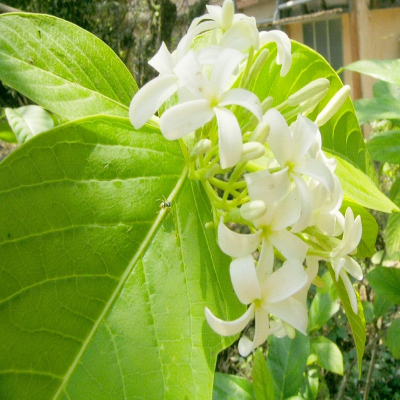Wrightia tinctoria (Roxb.) R.Br.
Family : Apocynaceae
Group : Anti-dandruff/Hair growth promoters
Parts Used : Leaf , Seed , Bark
Vernacular Names :-
| English | : | Pala indigo |
| Malayalam | : | Dantappala |
| Hindi | : | Dudhi |
| Sanskrit | : | Svetakutajah |
| Bengali | : | Indragalu |
| Kannada | : | Kirikodasige |
| Tamil | : | Tantampalai |
| Telungu | : | Jeddapala |
Distribution and habitat: Throughout India.
Botany: A small deciduous tree, upto 10 m in height with pale grey, smooth, thin bark abounding in yellow milky juice with opposite divaricate branches.
- Leaves : Simple, opposite, elliptic – ovate or obovate-oblong, acuminate, glabrous, main nerves 6-12 pairs.
- Flowers : White fragrant, in lax terminal cymes.
- Fruits : Follicle in pairs, pendulous, cylindrical, tips adhering at first. Seeds linear, pointed at the apex with a deciduous coma.
Properties:
- The leaves are acrid, thermogenic, anodyne and hypertensive.
- The bark and seeds are bitter, astringent, acrid, thermogenic, carminative, digestive, stomachic, constipative, depurative, anthelmentic, aphrodisiac and febrifuge.
Chemical constituents: β-amyrin
Uses:
- They are useful in vitiated conditions of pitta and kapha dyspepsia, flatulence, colic, diarrhoea, leprosy, psoriasis, hemorrhoids, dipsia, helminthiasis, fever, burning sensation and dropsy.
- The latex of the bark and unripe fruits are used by hill tribes for coagulating and solidifying milk.
- Oil preparation of the leaf offers wonderful cure for psoriasis.
Formulations: Svetakutaja
Agrotechnology
Climate and soil: The tree is well distributed in Western Ghats, Deccan, parts of Gujarat and Konkan areas.
Propagation: Seeds. Overnight soaking in water is preferred.
Planting: 2-3 week old seedlings are transplanted at a spacing of 5 m x 5 m. Maintain height of 2-3 m by pruning.
Irrigation: Irrigate the plants regularly till it establishes.

